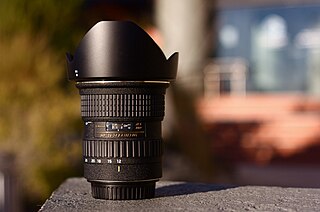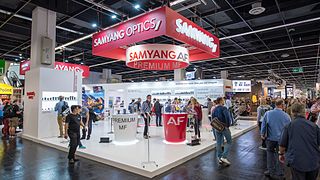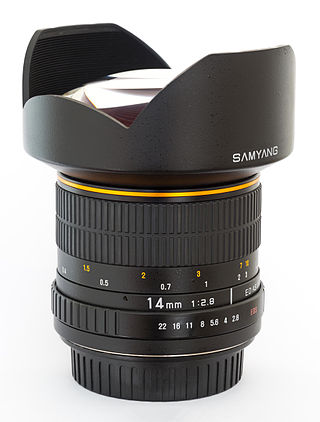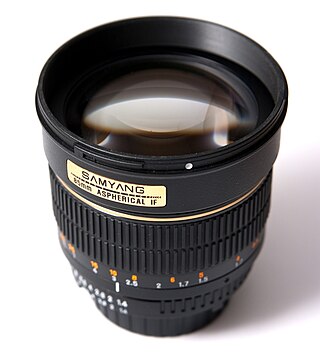
A rangefinder camera is a camera fitted with a rangefinder, typically a split-image rangefinder: a range-finding focusing mechanism allowing the photographer to measure the subject distance and take photographs that are in sharp focus. Most varieties of rangefinder show two images of the same subject, one of which moves when a calibrated wheel is turned; when the two images coincide and fuse into one, the distance can be read off the wheel. Older, non-coupled rangefinder cameras display the focusing distance and require the photographer to transfer the value to the lens focus ring; cameras without built-in rangefinders could have an external rangefinder fitted into the accessory shoe. Earlier cameras of this type had separate viewfinder and rangefinder windows; later the rangefinder was incorporated into the viewfinder. More modern designs have rangefinders coupled to the focusing mechanism so that the lens is focused correctly when the rangefinder images fuse; compare with the focusing screen in non-autofocus SLRs.

The EF lens mount is the standard lens mount on the Canon EOS family of SLR film and digital cameras. EF stands for "Electro-Focus": automatic focusing on EF lenses is handled by a dedicated electric motor built into the lens. Mechanically, it is a bayonet-style mount, and all communication between camera and lens takes place through electrical contacts; there are no mechanical levers or plungers. The mount was first introduced in 1987.

Cosina Co., Ltd. is a manufacturer of high-end optical glass, optical precision equipment, cameras, video and electronic related equipment, based in Nakano, Nagano Prefecture, Japan.
Soligor was originally the trade mark for the American Allied Impex Corporation, used from 1956 for lenses and later cameras imported from Japan. It imported cameras from Japan and also took control of companies in Japan. Among the first products was Miranda T camera and Soligor lenses.

The Pentax K-mount, sometimes referred to as the "PK-mount", is a bayonet lens mount standard for mounting interchangeable photographic lenses to 35 mm single-lens reflex (SLR) cameras. It was created by Pentax in 1975, and has since been used by all Pentax 35 mm and digital SLRs and also the MILC Pentax K-01. A number of other manufacturers have also produced many K-mount lenses and K-mount cameras.

The Nikon FM10 is a manual focus 35 mm film camera sold by Nikon Corporation. It is of SLR design and was first available in 1995. It is normally sold in a kit that includes a Zoom Nikkor 35–70 mm f/3.5-4.8 zoom lens, although a Zoom Nikkor 70–210 mm f/4.5-5.6 zoom lens is also available. An electronic companion model known as the FE10 was also sold at one stage.

Tokina Co., Ltd. is a Japanese manufacturer of photographic lenses and CCTV security equipment.

Kiron Lenses were photographic lenses distributed by the Kiron Corporation, formerly based in Carson, California, United States.

Pentax lenses were first badged as Takumar. The Takumar branded lenses were well respected for their line of Super Takumar, which designated the high performance coating applied to the lens as well as the optical formulas used to make them. The majority of the industry at the time was still satisfied with the variations of the "plumb" coating process and later some of the two and three layer processes as well. Asahi Pentax soon introduced the Takumar Super-Multi-Coated line of lenses which was a 7 layer process as the industry had just caught up with similar forms of 5 layer multi-coated optics. Eventually Asahi Optical and Pentax slowly shifted much of their lens production under the Pentax name and transitioned some of the successful designs that were first introduced under the Takumar name to use Asahi/Pentax badging as well as beginning to use the "smc" abbreviation. Eventually the Asahi partnership disappeared and the Pentax name became solely used. Pentax lenses saw many feature changes to answer the market, such as: incorporating "Auto-Aperture" with the M42, the light weight and compactness with the 'M' series, Aperture Priority overrides with the 'A' series, and Auto-Focus with the 'F' series. Modern Pentax lenses for digital SLR cameras have seen the elimination of the aperture ring completely as found on Pentax DA and D-FA series lenses. They use the Pentax KAF mount. All of these lenses have an autofocus feature, either operated from the camera body or from an internal SDM motor. Pentax compatible lenses are also made by third-party companies.
The Samsung NX-mount is the lens mount used on NX series mirrorless interchangeable lens cameras by Samsung. The mount was first implemented in the Samsung NX10, and Samsung initially referred to the NX line as 'hybrid digital cameras', citing their combination of attributes of both DSLR and compact cameras.

Samyang Optics is a South Korean manufacturer of camera lenses for several major brands of third-party mounts for still photography and video cameras. The company was founded in 1972 and has about 150 employees. Samyang exports to 58 countries through 39 overseas agents and distributors.

The Samyang 14mm f/2.8 ED AS IF UMC is Samyang's ultra wide angle prime lens for the 35 mm film format. It replaces the shortly sold Samyang 14mm f/2.8 IF ED MC Aspherical.

The Samyang 85mm f/1.4 IF Aspherical is Samyang's 35mm format moderate telephoto prime lens for portraiture.

The Fujifilm X-mount is a type of interchangeable lens mount designed by Fujifilm for use in those cameras in their X-series line that have interchangeable-lenses. These lenses are designed for 23.6mm x 15.6mm APS-C sensors.

The Samyang 8mm F3.5 UMC Fish-Eye CS II is a fisheye photographic lens using the stereographic projection and is designed for crop factor APS-C DSLRs. It is made in South Korea by Samyang Optics and marketed under several brand names besides Samyang, including Bower, Falcon, Polar, Pro-Optic, Rokinon, Vivitar and Walimex Pro. There are versions for the Canon EF, Fujifilm X, Nikon F, MFT, Pentax K, Samsung NX, Sony E, Sony α/Minolta A mounts.

The Canon RF lens mount is an interchangeable-lens mount developed by Canon for its full-frame mirrorless interchangeable-lens cameras, and featured first by the EOS R, followed by the EOS RP. The RF mount was announced in September 2018. In May 2022, Canon announced APS-C EOS R cameras and RF-S lenses designed for these cameras.

The name Summarit is used by Leica to designate camera lenses that have a maximum aperture of f/2.4. The name has been in used since 1949.























